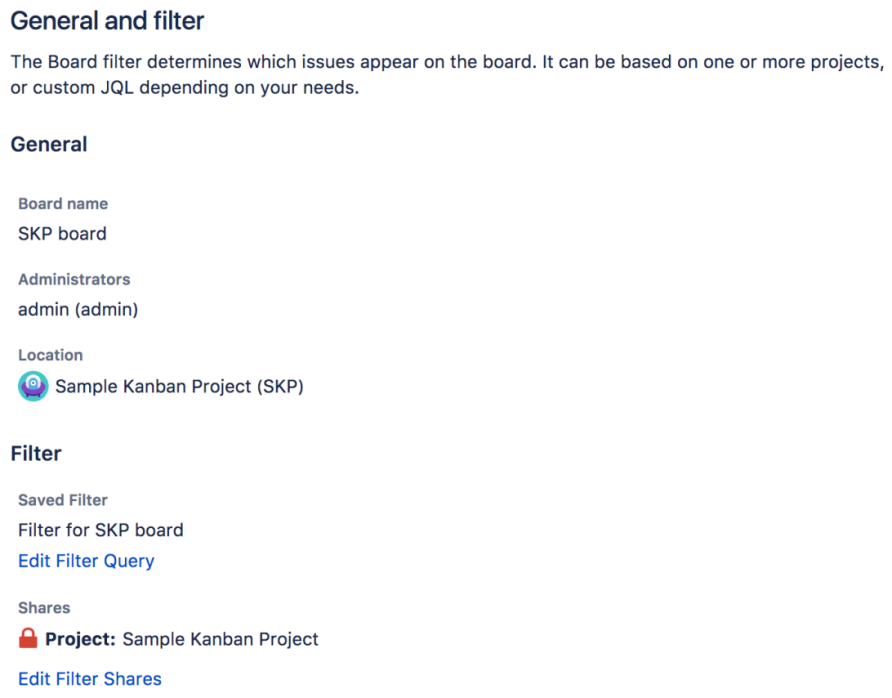| Iframe | ||||||
|---|---|---|---|---|---|---|
|
Configure a company-managed board
This page applies to company-managed projects only.
Learn more about the difference between company-managed and team-managed projects.
Configuring a board lets you edit the mapping of workflow statuses to columns of a board, as well as edit the columns, swimlanes, and quick filters of a board, and customize the card colors and displayed issue fields.
Before you begin
To configure the board and any of its settings, you must be either:
a project administrator for the location of the board
a board administrator for the board itself
See Permissions overview for more information.
Access board settings
Go to your board, then select more () > Configure board.
On the Board settings screen, select the desired tab (Columns, Swimlanes, etc).
For a Scrum board
For a Kanban board
If you need to see both the selected issue and the rest of your scrum or kanban board, you can choose to open the new Jira issue view as a right sidebar. To do it, go to a board and choose > Open issues in sidebar.
Rename a board
Go to your board, then select more () > Configure board.
On the board settings screen, click the 'pencil' icon(which will appear when you hover) to edit the name of your board. Press the Enter key when finished.
Delete a board
Click in the search field (or press /) and choose View all boards.
Find your board and select more () > Delete.
This will delete the board, but not the board's issues. This is because issues belong to the project, and boards are simply another way to view issues.
Change a board's administrators
A board's administrator is the only person who can change the configuration of a board along with Jira administrator users. By default, the administrator of a board includes the person who created it. If you're a board administrator or a Jira administrator, you can change the administrators of a board. See Permissions overview for more information.
Go to your board, then select more () > Configure board.
On the board settings screen, click any of the names in the Administrators field (a 'pencil' iconwill appear when you hover over them).
Enter the names of the desired users or groups. If you start typing the name, a list of users and groups will be suggested. Press the Enter key when finished.
The suggested user list will not display if you don't have the Browse users and groups global permission. However, you can still enter the user names and group names manually. See Permissions overview for more information.
You may also want to give the new administrators rights to manage the Jira filter on which the board is based – see the Jira admin documentation on Managing shared filters.
Sharing a board
A board is available to all users who can view the saved filter on which the board is based. Note that they'll also need Browse project permission for the project(s) whose issues are shown on the board. See Permissions overview for more information.
To share a board with different people, you'll need to either edit the saved filter (see the documentation on issue filters), or choose a different filter (see Configuring filters).
Need help? If you can't find the answer you need in our documentation, we have other resources available to help you. See Getting help.
What are board filters?
Learn what a board is, and how you can use it to define a board.
Enable ranking
Enable ranking on a board to rank issues and create sprints on scrum boards.
Configure columns
Learn how to configure columns on a board to map them to a Jira workflow status, and more.
Configure swimlanes
Configure swimlanes on a board to help you distinguish tasks of different categories, like workstreams.
Configure quick filters
Configure quick filters on a board to help you switch between issue types or show team-specific views of a common backlog.
Customize cards
Customize the layout, colors, and fields on the cards on your board.
Configure how your board estimates and tracks work
Configure how you estimate work and track time in your project.
Configure the issue detail view
Customize the issue view to show more fields, hide fields, and rearrange the field layout.
Configure working days
Change the working days setting for your board to filter out weekends, holidays, and other times.
Change the location of a board
Change the location of agile boards. Boards can be located in a project or in your profile.
Add a sub-filter to a company-managed kanban board
Add a sub-filter to your company-managed Kanban board.
Can I use custom fields to track progress of my project?
Use a custom numeric field to track time throughout your project in Jira.
Change board filters for a company-managed board
Change which board filter your company managed board uses.
Edit a board filter on a company-managed board
Edit the board filter being used by your company managed board.
How can I track progress of my projects in Jira?
Learn how Jira tracks progress of projects and how it can help you plan.
Show or hide issues on your board with quick filters
Show or hide issues in your board based on specific criteria using a filter.
What are story points?
Learn what story points are, and how to use them to estimate work.
What are Time estimates (days, hours, minutes)?
Learn how to use time-based units (minutes, hours, days) to estimate work.
What is estimation in Jira?
Learn more about estimation and how it can help you plan projects in Jira.
What is Issue count?
Learn the ins-and-outs of using issue count to track progress on a board.

